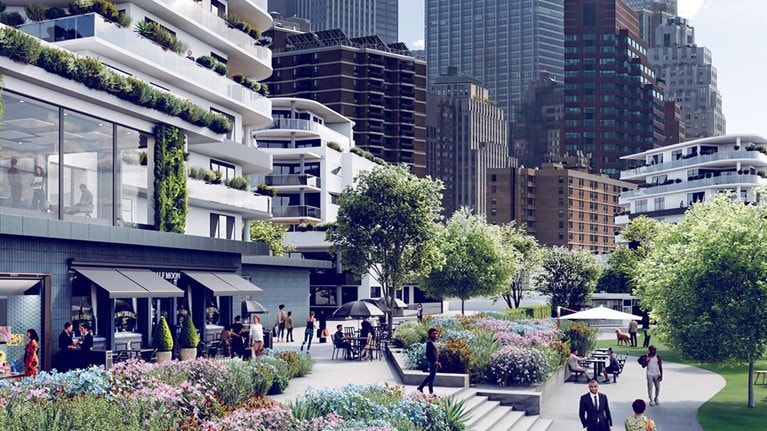In this episode of Deal Volume, McKinsey’s podcast on private markets, McKinsey partner and host Brian Vickery speaks to David Steinbach, the global chief investment officer and cohead of investment management at Hines, one of the largest real estate investors, developers, and service providers in the world. Vickery and Steinbach unpack the findings in the McKinsey Global Institute’s recent report “Empty spaces and hybrid places: The pandemic’s lasting impact on real estate.”1 The report explores the implications of hybrid work for real estate today and into the future. Vickery taps into Steinbach’s decades-long career to discuss what he foresees for the industry and how stakeholders can change to rethink space, satisfy tenants, and preserve real estate companies’ success. An edited version of their conversation follows.
The future of real estate and the future of work
Brian Vickery: Where do you see the office market today, and how is our current situation an outcome of a much longer-term arc? Our report focused on the impact of hybrid work over the past few years and how that behavioral change has affected real estate, but that’s only one part of a longer history.
David Steinbach: A lot was occurring well before COVID-19 happened. Real estate was becoming a service industry, and a convergence of product types such as multifamily, retail, and even industrial was under way. In fact, the creation of ecosystems was driving performance in the market. COVID-19 was an accelerant that caused what was already happening to move forward sooner.
When considering the history of the office market in the United States, tax reform2 in the 1980s drove a lot of development and even oversupply in most markets. There was the creation of certain funds afterward that erected a lot of that real estate but underinvested in those office buildings for about 15 years. Then interest rates were at 0 percent for about 15 years. All these forces created a dynamic where landlords were incentivized to increase rent and create higher tenant inducements, which distorted the dynamics of supply and demand within office buildings and the expectations tenants have.
So today, there is a lot to unwind. Forty years of incompatible events have caused the real estate industry to get where it is. It’s important to know this historical context when you think about offices more broadly.
Brian Vickery: Real estate has become experiential while these cultural changes are happening, making many buildings today unfit for purpose.
David Steinbach: Owners of real estate don’t fully know what to do in this new world. If real estate is becoming a service industry and there’s a shift in tenant expectations, not everyone can deliver upon those changing dynamics. Some of the hardware elements in buildings—the bricks and mortar that make it up—are no longer useful or relevant. They need to be radically changed because they don’t fit the taste of the modern employee. But the software elements—the execution piece that happens inside the four walls—also needs to radically evolve to match employees’ changing tastes.
Finding broad pools of opportunity
Brian Vickery: How are you drawing the line between existential threats and pockets of opportunity?
David Steinbach: We can compare this moment in real estate with what happened in retail about ten years ago when e-commerce became popular. There was so much excitement about logistics and the opportunity there. It was certainly a deep pool of opportunity and demand; a lot needed to be built to service the emerging economy. At the same time, if you had painted a broad brush on retail and invested only in e-commerce, you would’ve missed a lot of opportunities. We saw that the best retail centers did well over the past ten years in terms of rents and footfall and were resilient through COVID-19.
Similarly, one mistake that real estate investors could make is painting their brush too broadly in today’s market. Right now, people are more interested in multifamily or industrial buildings, but the pools of opportunity there are only so deep. We can’t all buy only those two product types and still expect them to be priced to perfection. A smart investor needs to look broadly at the lay of the land and, at every opportunity, think about offices in addition to all the other sectors and have a vision for what will withstand.
Brian Vickery: Certain locations and building types with the right amenities and experiences outperform the ones that don’t have these features, but those places may have moved as the population has shifted.
David Steinbach: When I started underwriting deals years ago, everyone talked about the value of building near executive housing. About a decade ago, it shifted to building where younger people want to be. The next shift could be more about the ecosystem—a convergence of features that makes a place special. Location is important, but it’s not the only metric that matters.
How cities may respond to shifting demographics
Brian Vickery: In our report, we found cities that have dense office-centric neighborhoods and less of a mixed-use environment haven’t seen the foot traffic and population growth that other cities have. Moreover, transit patterns may have shifted, and location for multifamily, retail, and office real estate matters more than ever. Why do you think the broader landscape has changed in the past five years?
David Steinbach: The experience economy is driving a lot of behavior. The demographic profile of many major economies around the world, including the United States, is undergoing some changes. Real estate developers and investors chased millennials as they matured out of universities and moved into urban environments. As that population ages, their needs are going to change, too.
Some of that impact will spread out: many who went to some major markets may want to move closer to home as they have children, as their parents age, or for other reasons. They may also bring a lot of the urban sensibilities they had to other cities, which provides an opportunity to recalibrate how we think about what we’re providing. The built environment responds to demand, and that would be a deep pool of demand.
Responding appropriately to shifting demographics depends on the market you’re in. It’s important to recognize where new demographics see opportunity and how things must evolve in response. The negativity around urbanization is a bit overdone. Cities will rework themselves. We’re already seeing that in New York and San Francisco.
Brian Vickery: That’s an important nuance. The people who moved during COVID-19 aren’t moving back, but that doesn’t mean other people aren’t moving in. Cities still have a magnetism for younger generations.
Rethinking spaces
Brian Vickery: It will take us a long time to witness how hybrid work has truly affected asset classes. Some seasoned investors have been saying that it could take up to ten years. In an unmanaged scenario, we found that office demand in a median city was down by 13 percent, and in a dire scenario, some cities were down by 38 percent. What do you think needs to happen to avoid this prolonged period of uncertainty?
David Steinbach: Cities right now are open to change because they’re seeing their tax base erode, lenders don’t want buildings back, and equity holders want to create new opportunities. Importantly, tenants are also open to change. One tipping point for disruption is the alignment of stakeholders, and this uncommon moment will accelerate a lot of change in our industry. Forward-leaning owners and operators, developers, and investors are going to embrace that, and it won’t be a decade in the making.
Brian Vickery: Tenants are dealing with a lot of uncertainty. They don’t want to sign a ten-year lease because they don’t know how much space they’ll need in two years. So the model is not working right now.
David Steinbach: It’s all about the customer—the one who’s paying the rent. Real estate has lagged behind in its ability to keep up with customer demand and get ahead of what customers want. Data has helped companies greatly. Years ago, for example, we sent people to count cars to estimate a building’s vacancy rate. Better data has allowed us to know exactly what a building’s vacancy rate is, which helped performance. Productivity will be the next wave. Right now, we don’t know what is going on inside a building from the outside, but as we get closer to our tenants, this data will help us approach new builds based on their needs.
Brian Vickery: That will revolutionize how we think about space, changing from square footage to being about what we’re trying to accomplish within the space. Employers know they have to attract and retain people and keep them happy when they’re in the office. Employees want a space that is social, creative, and collaborative, which is against the old cubicle mindset.
David Steinbach: Historically, offices housed the means of production. Think about how radically the means of production have changed. Our technology has shrunk, and companies within the knowledge economy have created a wave of differentiation based on their response to these changes. The real estate industry has been slow to respond, but there will be a new wave of thinking in terms of how we serve our tenants and new ways to make money. There’s an opportunity to remake what the future of our industry looks like.


